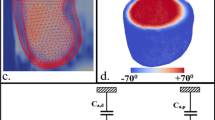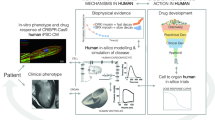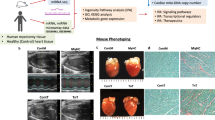Abstract
Familial hypertrophic cardiomyopathy (FHC) is a genetic disorder resulting from mutations in genes encoding sarcomeric proteins1,2. This typically induces hyperdynamic ejection3, impaired relaxation, delayed early filling4, myocyte disarray and fibrosis, and increased chamber end-systolic stiffness5,6. To better understand the disease pathogenesis, early (primary) abnormalities must be distinguished from evolving responses to the genetic defect. We did in vivo analysis using a mouse model of FHC with an Arg403Gln α-cardiac myosin heavy chain missense mutation7, and used newly developed methods for assessing in situ pressure–volume relations8. Hearts of young mutant mice (6 weeks old), which show no chamber morphologic or gross histologic abnormalities, had altered contraction kinetics, with considerably delayed pressure relaxation and chamber filling, yet accelerated systolic pressure rise. Older mutant mice (20 weeks old), which develop fiber disarray and fibrosis, had diastolic and systolic kinetic changes similar to if not slightly less than those of younger mice. However, the hearts of older mutant mice also showed hyperdynamic contraction, with increased end-systolic chamber stiffness, outflow tract pressure gradients and a lower cardiac index due to reduced chamber filling; all 'hallmarks' of human disease. These data provide new insights into the temporal evolution of FHC. Such data may help direct new therapeutic strategies to diminish disease progression.
This is a preview of subscription content, access via your institution
Access options
Subscribe to this journal
Receive 12 print issues and online access
$209.00 per year
only $17.42 per issue
Buy this article
- Purchase on Springer Link
- Instant access to full article PDF
Prices may be subject to local taxes which are calculated during checkout


Similar content being viewed by others
References
Seidman, C.E. & Seidman, J.G. in Molecular Cardiovascular Medicine (ed. E. Haber, E.) 193–210 (Scientific American Press, New York, 1995).
Watkins, H. et al. Characteristics and prognostic implications of myosin missense mutations in familial hypertrophic cardiomyopathy. N. Engl. J. Med. 326, 1108–1114 (1992).
Wigle, E.D., Rakowski, H., Kimball, B.P. & Williams, W.G. Hypertrophic cardiomyopathy: Clinical spectrum and treatment. Circulation 92, 1680–1692 (1995).
Bonow, R.O. et al. Effects of verapamil on left ventricular systolic and diastolic function in patients with hypertrophic cardiomyopathy: pressure-volume analysis with a nonimaging scintillation probe. Circulation 68, 1062–1073 (1983).
Pak, P.H., Maughan, W.L., Baughman, K.L. & Kass, D.A. Marked discordance between dynamic and passive diastolic pressure-volume relations in idiopathic hypertrophic cardiomyopathy. Circulation 94, 52–60 (1996).
Pak, P.H., Maughan, W.L., Baughman, K.L., Caval, R.S. & Kass, D.A. Mechanism of acute mechanical benefit from VDD pacing in hypertrophied heart: Similarity of responses in hypertrophic cardiomyopathy and hypertensive heart disease. Circulation 98, 242–248 (1998).
Geisterfer-Lowrance, A.T. et al. A mouse model of familial hypertrophic cardiomyopathy. Science 272, 731–744 ( 1996).
Georgakopoulos, D. et al. In vivo murine left ventricular pressure-volume relations by miniaturized conductance-micromanometry. Am. J. Physiol. 274(4 Pt 2), H1416–H1422 ( 1998).
Shen, Y-T., Cervoni, P., Claus, T. & Vatner, S.F. Differences in β3-adrenergic receptor cardiovascular regulation in conscious primates, rats and dogs. J. Pharmacol. Exp. Ther. 278, 1435–1443 (1996).
Suga, H. & Sagawa, K. Instantaneous pressure-volume relationships and their ratio in the excised, supported canine left ventricle. Circ. Res. 35, 117–128 ( 1974).
Spindler, M. et al. Diastolic dysfunction and altered energetics in the αMHC403/+ mouse model of familial hpertrophic cardiomyopathy. J. Clin. Invest. 101, 1775–1783 (1998).
Kapuku, G.K. et al. Impaired left ventricular filling in borderline hypertensive patients without cardiac structural changes. Am. Heart J. 125, 1710–1716 (1993).
Palatini, P. et al. Structural abnormalities and not diastolic dysfunction are the earliest left ventricular changes in hypertension. Am. J. Hypertens. 11, 147–154 ( 1998).
Tardiff, J.C. et al. A truncated cardiac troponin T molecule in transgenic mice suggests multiple cellular mechanisms for familial hypertrophic cardiomyopathy. J. Clin. Invest. 107, 2800– 2811 (1998).
Oberst, L. et al. Dominant-negative effect of a mutant cardiac troponin T on cardiac structure and function in transgenic mice. J. Clin. Invest. 102,1498–1505 ( 1998).
Gottshall, K.R. et al. Ras-dependent pathways induce obstructive hypertrophy in echo-selected transgenic mice. Proc. Natl. Acad. Sci. USA 94(9), 4710–4715 (1997).
Milano, C.A. et al. Enhanced myocardial function in transgenic mice overexpressing the beta 2-adrenergic receptor. Science 264, 582–586 (1994).
Grupp, I.L. et al. Overexpression of alpha-1 adrenergic receptor induces left ventricular dysfunction in the absence of hypertrophy. Am. J. Physiol. 275(4 Pt 2), H1338–H1350 (1998).
Lorenz, J.N. & Kranias, E.G. Regulatory effects of phospholamban on cardiac function in intact mice. Am. J. Physiol. 273, H2826–H2831 (1997).
Maughan, D.W. et al. Altered crossbridge kinetics of permeabilized myocardium from a mouse model of Arg403Gln familial hypertrophic cardiomyopathy. Circulation 98, I–625 ( 1998).
Rayment, I. et al. Structure of the actin-myosin complex and its implications for muscle contraction. Science 261, 58– 65 (1993).
Sweeney, H.L. et al. Heterologous expression of a cardiomyopathic myosin that is defective in its actin interaction. J. Biol. Chem. 269, 1603–1605 (1994).
Sutton, M.St.J. & Epstein, J.A. Hypertrophic cardiomyopathy: Beyond the sarcomere . N. Engl. J. Med. 338, 1303–1304 (1998).
Welch, W.J. et al. Validation of miniature ultrasonic transit-time flow probes for measurement of renal blood flow in rats. Am. J. Physiol. 268, F175–178 (1995).
Wen C. et al. Validation of transonic small animal flowmeter for measurement of cardiac output and regional blood flow in the rat. J. Cardiovasc. Pharm. 27, 482–486 ( 1996).
Author information
Authors and Affiliations
Corresponding author
Rights and permissions
About this article
Cite this article
Georgakopoulos, D., Christe, M., Giewat, M. et al. The pathogenesis of familial hypertrophic cardiomyopathy: Early and evolving effects from an α-cardiac myosin heavy chain missense mutation. Nat Med 5, 327–330 (1999). https://doi.org/10.1038/6549
Received:
Accepted:
Issue Date:
DOI: https://doi.org/10.1038/6549
This article is cited by
-
MYH7 in cardiomyopathy and skeletal muscle myopathy
Molecular and Cellular Biochemistry (2024)
-
Pharmacological Management of Hypertrophic Cardiomyopathy: From Bench to Bedside
Drugs (2022)
-
Comparative analysis of functional assay evidence use by ClinGen Variant Curation Expert Panels
Genome Medicine (2019)
-
Age-related changes in familial hypertrophic cardiomyopathy phenotype in transgenic mice and humans
Journal of Huazhong University of Science and Technology [Medical Sciences] (2014)
-
Hypertrophic Cardiomyopathy: Preclinical and Early Phenotype
Journal of Cardiovascular Translational Research (2009)



